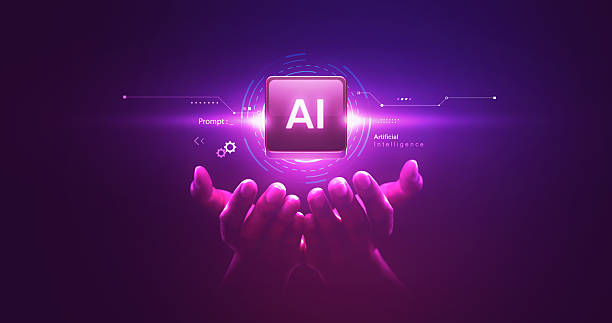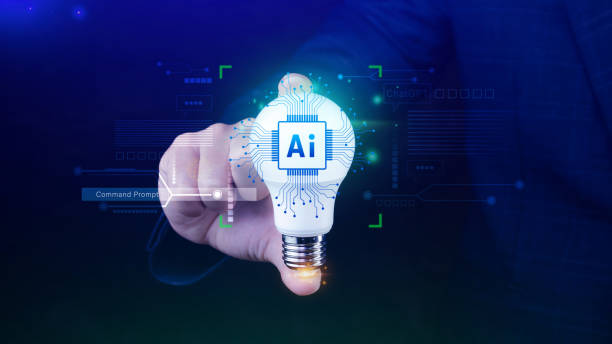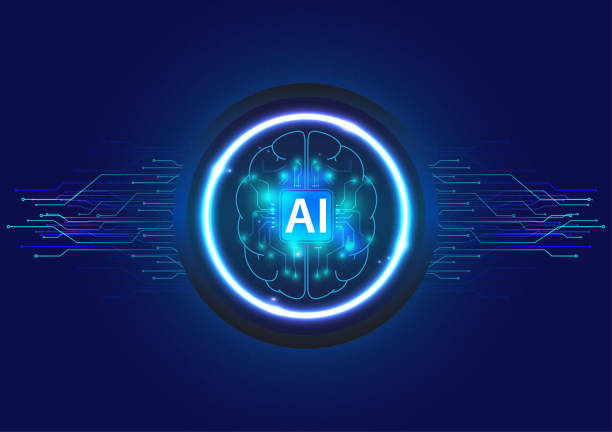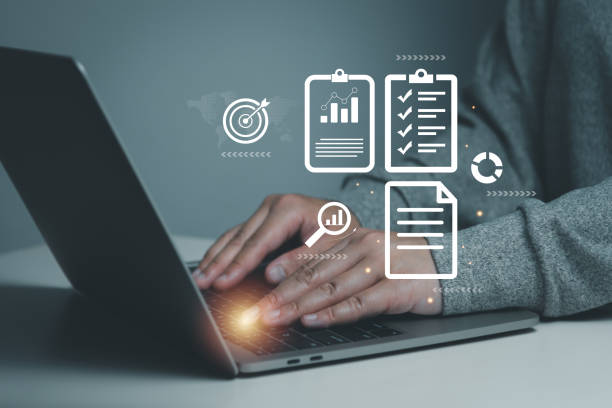What is an AI Robot and What are its Applications?
![]()
#AI Robot is a combination of two distinct fields: robotics and artificial intelligence.
In simple terms, an AI robot is a machine capable of performing tasks that typically require human intelligence.
These tasks can include learning, reasoning, problem-solving, natural language understanding, and computer vision.
AI robots use complex algorithms and models to process data and make decisions.
The applications of AI robots are very broad and are used in various industries.
These applications include:
- Manufacturing Industry: Using robots to automate production lines, increase accuracy, and reduce costs.
- Customer Service: Providing 24/7 support, answering frequently asked questions, and guiding customers.
- Healthcare: Assisting surgeons in performing complex operations, providing patient care at home, and diagnosing diseases.
- Finance: Conducting automated transactions, detecting fraud, and managing risk.
- Education: Providing personalized education, answering student questions, and evaluating their performance.
AI robots are rapidly advancing, and they are expected to play a more important role in our lives in the future.
These robots can help us perform daily tasks, increase productivity, and improve the quality of life.
Are you tired of your company’s website not being seen as it should be, and losing potential customers? Solve this problem forever with professional and effective website design by Rasaweb!
✅ Increase brand credibility and build customer trust
✅ Attract targeted sales leads
⚡ Contact us now for a free consultation!
Types of AI Robots and Their Features

AI robots can be categorized based on various criteria.
One of the most common methods is categorization based on the type of task the robot is capable of performing.
Based on this, AI robots can be divided into the following categories:
- Industrial Robots: These robots are designed to perform repetitive and precise tasks on production lines.
- Service Robots: These robots are designed to provide services to humans in various environments.
- Medical Robots: These robots are designed to assist doctors in performing surgeries, providing patient care, and diagnosing diseases.
- Educational Robots: These robots are designed to provide personalized education to students.
- Military Robots: These robots are designed to perform dangerous and difficult tasks in war environments.
In addition to the type of task, AI robots can also be categorized based on their level of intelligence.
Based on this, AI robots can be divided into the following three categories:
- Narrow AI: This type of AI is only capable of performing a specific task.
- General AI: This type of AI is capable of performing any task that a human can perform.
- Super AI: This type of AI surpasses human intelligence.
Currently, most AI robots fall into the Narrow AI category.
The development of General AI and Super AI is still in its early stages.
Main Components of an AI Robot

An AI robot consists of several main components that work together to enable various tasks.
These components include:
- Sensors: Sensors collect information about the surrounding environment.
This information can include images, sounds, temperature, pressure, and other physical parameters. - Processor: The processor processes the information collected by the sensors and makes the necessary decisions.
- Actuators: Actuators enable the robot to move in the surrounding environment and interact with it.
- AI Software: AI software provides the algorithms and models that the robot needs to learn, reason, and solve problems.
- Power Source: The power source provides the energy required for the robot to function.
The interaction of these components enables the AI robot to perform complex tasks.
For example, a self-driving car uses various sensors such as cameras, lidar, and radar to collect information about the surrounding environment.
Then, the processor processes this information and makes the necessary decisions for safe driving.
Finally, the actuators enable the robot to execute commands and move in the right direction.
| Component | Description |
|---|---|
| Sensors | Collect information from the environment |
| Processor | Process information and make decisions |
| Actuators | Movement and interaction with the environment |
| AI Software | Algorithms and learning models |
Key Algorithms in AI Robots

AI algorithms play a fundamental role in the performance of AI robots.
These algorithms enable robots to learn from data, reason, solve problems, and make informed decisions.
Some of the key algorithms used in AI robots include:
- Machine Learning: These algorithms enable robots to learn from data and improve their performance.
- Neural Networks: These algorithms are inspired by the structure of the human brain and are used to process complex information and recognize patterns.
- Natural Language Processing (NLP): These algorithms enable robots to understand and communicate with human language.
- Computer Vision: These algorithms enable robots to process images and videos and recognize objects and people.
- Planning: These algorithms enable robots to plan to achieve their goals and choose the appropriate path.
The choice of the appropriate algorithm for an AI robot depends on the type of task the robot needs to perform.
For example, a facial recognition robot uses computer vision algorithms, while a chatbot uses natural language processing algorithms.
Does your company’s website perform as well as your brand deserves? In today’s competitive world, your website is your most important online tool. Rasaweb, a specialist in professional corporate website design, helps you to:
✅ Gain credibility and customer trust
✅ Convert website visitors into customers
⚡ Get a free consultation!
Challenges in Developing AI Robots

The development of AI robots comes with several challenges.
Some of these challenges include:
- Collecting Sufficient Data: AI algorithms require a large amount of data to learn.
Collecting sufficient and high-quality data can be a major challenge. - Developing Efficient Algorithms: AI algorithms must be efficient and fast to make the necessary decisions in real-time.
- Safety and Reliability: AI robots must be safe and reliable to prevent accidents.
- Ethical Issues: The use of AI robots comes with several ethical issues.
For example, it must be ensured that robots are not discriminatory and respect human rights. - Cost: Developing and deploying AI robots can be very expensive.
Overcoming these challenges requires joint efforts by researchers, engineers, policymakers, and ethics experts.
By solving these challenges, the potential benefits of AI robots can be harnessed, and their potential risks can be avoided.
The Future of AI Robots

The future of AI robots looks very bright.
Rapid advances in artificial intelligence, robotics, and related technologies promise tremendous transformations in various industries and our daily lives.
AI robots are expected to play a more important role in performing various tasks in the future, increasing productivity, and improving the quality of life.
Some predictions regarding the future of AI robots include:
- Expanding the Application of Robots in Various Industries: AI robots will be increasingly used in various industries such as manufacturing, services, healthcare, finance, and education.
- Developing Autonomous Robots: Autonomous robots will be able to perform complex tasks without human intervention.
- Developing Social Robots: Social robots will be able to communicate with humans and assist them.
- Integrating Robots with the Internet of Things (IoT): Integrating robots with the Internet of Things allows for the collection and exchange of data between robots and other devices.
- Developing Artificial General Intelligence (AGI): The development of artificial general intelligence will enable robots that can perform any task that humans can.
Of course, the development of AI robots is also accompanied by ethical and social challenges that must be addressed.
However, by properly managing these challenges, the potential benefits of AI robots can be harnessed and a better future can be created for all.
In the meantime, artificial intelligence plays a fundamental role as the beating heart of these robots.
How to Design an AI Robot?

Designing an AI robot is a complex and multi-step process that requires knowledge and expertise in various fields such as robotics, artificial intelligence, programming, and electronics.
Here is an overview of the main steps in designing an AI robot:
- Define the Goal: The first step in designing an AI robot is to define the goal and determine the tasks the robot should perform.
- Choose the Platform: The robot platform includes the hardware and software on which the robot is built.
Choosing the right platform depends on the type of tasks the robot needs to perform. - Hardware Design: Hardware design includes selecting the appropriate sensors, actuators, processor, and power source.
- Software Development: Software development includes implementing AI algorithms, programming the robot controller, and designing the user interface.
- Testing and Evaluation: After the design and development are complete, the robot must be fully tested and evaluated to ensure that it works correctly and achieves the desired goals.
To succeed in designing an AI robot, it is necessary to be familiar with the latest advances in the fields of artificial intelligence and robotics and to use the appropriate tools and techniques.
Also, collaborating with experienced professionals in these fields can be very helpful.
| Step | Description |
|---|---|
| Define the Goal | Determine the robot’s tasks |
| Choose the Platform | Select hardware and software |
| Hardware Design | Select sensors and actuators |
| Software Development | Implement AI algorithms |
| Testing and Evaluation | Check the robot’s performance |
Impact of AI Robots on Jobs

AI robots have the potential to create dramatic changes in the labor market.
On the one hand, they can automate some jobs and lead to job losses.
On the other hand, they can create new jobs and increase productivity.
Some of the jobs that are most at risk of automation include:
- Repetitive and routine jobs
- Manufacturing jobs
- Clerical jobs
- Transportation jobs
On the other hand, AI robots can create new jobs in areas such as:
- Artificial intelligence
- Robotics
- Data science
- Software engineering
To adapt to changes in the labor market caused by AI robots, it is necessary for people to learn new skills and prepare for new jobs.
Governments and organizations should also provide appropriate training and support programs to help people in this area.
Are you tired of your company’s website failing to meet your expectations? With Rasaweb, design a professional website that showcases the true face of your business.
✅ Increase attraction of new customers and sales leads
✅ Increase the credibility and trust of your brand among your audience
⚡ Get a free website design consultation!
Ethical Issues Related to AI Robots

The development and use of AI robots is accompanied by several ethical issues that must be addressed.
Some of these issues include:
- Privacy: AI robots can collect and process a large amount of personal data.
It is necessary to enact appropriate laws and regulations to protect the privacy of individuals against the misuse of this data. - Discrimination: AI algorithms can inadvertently be discriminatory and lead to decisions that are detrimental to certain groups of people.
- Responsibility: If an AI robot causes damage, it is difficult to determine responsibility.
It is necessary to enact appropriate laws and regulations to determine responsibility in these cases. - Control: It must be ensured that AI robots are under human control and cannot make important decisions without human permission.
To resolve these ethical issues, it is necessary for ethics experts, policymakers, and AI robot developers to work together to provide appropriate solutions.
AI robots are for performing tasks that typically require human intelligence.
Educational Resources for Learning Robotics and Artificial Intelligence

Learning robotics and artificial intelligence can be an exciting and rewarding path.
Fortunately, there are numerous educational resources to help you on this path.
Some of these resources include:
- Online Courses: Online educational platforms such as Coursera, Udemy, and Edrak offer a variety of courses in robotics and artificial intelligence.
- Books: There are many books on robotics and artificial intelligence that you can use to learn basic and advanced concepts.
- Scientific Articles: Scientific articles published in reputable journals provide up-to-date information on the latest advances in robotics and artificial intelligence.
- Online Forums and Communities: Membership in online forums and communities of robotics and artificial intelligence provides an opportunity to connect with other enthusiasts and exchange information.
- Robotics Competitions: Participating in robotics competitions is a practical way to learn and apply robotics and artificial intelligence knowledge.
By using these educational resources, you can gain the knowledge and skills necessary to enter the world of robotics and artificial intelligence.
AI robots are at your service!
Frequently Asked Questions
| Question | Answer |
|---|---|
| What is an AI robot? | An AI Robot is a machine that is capable of understanding its environment, reasoning, learning, and making decisions to perform tasks independently. |
| What is the difference between regular robots and AI robots? | Regular robots perform repetitive tasks based on pre-programming, while AI robots can learn from experience, interact dynamically with the environment, and even behave in ways that resemble human intelligence. |
| What are the main applications of AI robots? | They have applications in industries (manufacturing, assembly), medicine (surgery, diagnosis), services (customer support, domestic), exploration (space, underwater), and many other fields. |
| What technologies are used in building AI robots? | Machine Learning, Computer Vision, Natural Language Processing, Deep Learning, and Robotics are some of the key technologies. |
| Can AI robots have emotions? | Currently, robots do not have emotions in the human sense. They can recognize and respond to emotions, but they do not experience them themselves. |
| What are the main challenges in developing AI robots? | Safety, reliability, ethics, autonomy, adaptability to complex environments, and natural interaction with humans are important challenges. |
| How are AI robots trained? | They are usually trained using large amounts of data, machine learning algorithms, and deep learning to identify patterns and make decisions. |
| Examples of AI robots in everyday life? | Smart robotic vacuum cleaners, customer support chat robots, self-driving cars, and surgical robots in hospitals. |
| Are AI robots a threat to human jobs? | Some repetitive jobs may be automated, but at the same time, robots can increase productivity and create new jobs in the development, maintenance, and monitoring of these systems. |
| How is the future of AI robots predicted? | They are expected to become smarter, more autonomous, and capable of performing more complex tasks, and will interact more closely with humans in various environments. |
and other services of Rasa Web Advertising Agency in the field of advertising
Smart Marketplace: A dedicated service for growth and increased sales based on marketing automation.
Smart Social Media: A novel service to increase user engagement through SEO-driven content strategy.
Smart Content Strategy: A dedicated service for growth and increased sales based on intelligent data analysis.
Smart Direct Marketing: A combination of creativity and technology to increase website traffic by optimizing key pages.
Smart Digital Advertising: An effective tool to attract customers with an attractive user interface design.
And more than a hundred other services in the field of internet advertising, advertising consulting, and organizational solutions
Internet Advertising | Advertising Strategy | Advertorial Reporting
Resources
Intelligent robots at your disposal; these tools are used for
,What is an AI robot and what are its applications?
,What is artificial intelligence and what is its application?
,Applications of intelligent robots in everyday life
? To reach the peaks of success in the digital world, Rasaweb Afarin Digital Marketing Agency, with expertise in SEO, content production, and user-friendly website design, paves the way for your business growth.
📍 Tehran, Mirdamad Street, next to the Central Bank, Southern Kazerun Alley, Ramin Alley No. 6
“`




